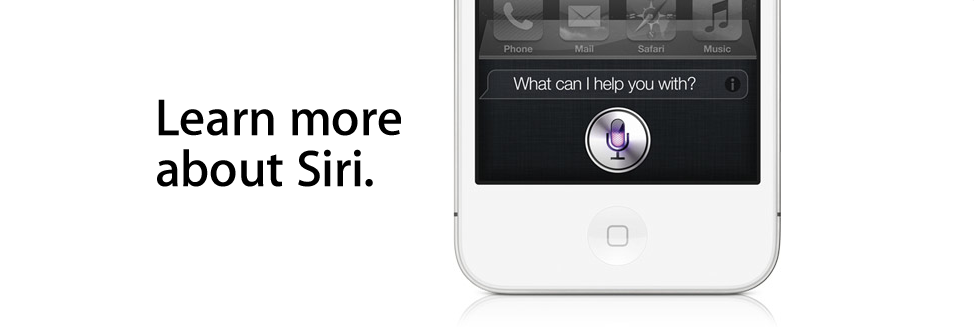

Voice control is not new. In 1961, IBM constructed a computer called the Shoebox that could perform mathematical functions using spoken digits as input. But to watch Apple’s iPhone 4S release and to read reviewers’ accounts of Siri, you would think this new generation of voice control is the next killer app. And, as surprising as that conclusion is, it might just turn out to be accurate.
Speech recognition has a bad rep. We’re sick of dealing with automated responses on customer service lines and we’re fed up with repeating our account number just one more time for those sterile, halting, disembodied tones we hear in response. iPhone voice control was no better in the past. Ask it to fire up your favorite playlist and half the time it would ring someone, forcing users to scramble for the big red “End Call” button to prevent an awkward apocalypse. For a long time, we’ve been conditioned to hate voice control.
But Siri has the competition running scared. Eric Schmidt, Google’s executive chairman and former CEO, called Siri a “significant development” that Google “failed to anticipate.” He expressed fears that Apple might use Siri, a “Google killer,” to break into the search engine business, Google’s lucrative home turf. Amazon, quiet by comparison, acquired a speech-recognition firm named Yap back in September. Furthermore, as The Atlantic reports, a U.S. Security and Commission (SEC) filing didn’t even name Amazon on the acquisition paperwork. Instead, it named “Dion Acquisition Sub,” which just so happens to share a headquarters address with an Amazon building. A secret purchase of a voice recognition firm a mere month before Apple announced Siri shows just how important Amazon thinks this competition will be.
The question we then have to ask ourselves and any other nerds willing to listen is: what makes Siri different? She’s coming from a long line of misfits — inaccurate recognition software that’s poisoned our conceptions of voice control for years. She’s fighting an uphill battle against customer expectations, and she’s winning.
Siri has attitude, but that’s not it. Humorous quips in response to inappropriate questions might provoke a laugh, but that’s not going to sell $200 worth of tech for most people. HAL 9000 references are worth a laugh, but that’s not enough to have Amazon and Google running scared.
Siri is an Apple product, but that’s not it either. It’d be an oversimplification, and a dishonest one at that, to chalk this up to another example of Apple software design. Being on a popular phone platform helps, but that’s not enough to make Siri such a success in her own right.
The secret is that Siri is old. She is the product of four decades of research, funded by the Defense Advanced Research Projects Agency (DARPA), and first conceived by Stanford Research Institute (SRI) International. After some time, two specific projects at SRI International, the Personalized Assistant That Learns Program and Cognitive Agent That Learns and Organizes, spun off into a small firm named Siri Inc. The research continued, Siri grew into an isolated iPhone app, and Apple took notice and purchased Siri Inc. Apple changed the packaging, adding a little attitude and a few tweaks, then introduced her to customers as its own personal assistant. Combine four decades of research with the now-sufficient speed of mobile processors and web connections, and you’ve got Siri.
But Siri’s just a beginning. Keyboards and mice are old news; most people can speak faster than they can type. Touch interfaces offer some improvements, but entering text on a four-inch screen gets old and using one on a desktop for extended periods of time (referred to as “Gorilla Arm”) is unpleasant for users. Voice control that recognizes contextual word usage unlocks another dimension of user interaction. We can initiate tasks and issue commands without stopping another task, communicating with our devices in the same manner we might communicate with a human assistant. It is no mistake that Siri knows a few HAL 9000 lines — she’s one step towards providing futuristic levels of user input (minus the murderous intent, we hope).
And these dreams don’t seem too far off. Right now, Siri belongs exclusively to the people who bought an iPhone 4S. But there have been murmurs that Apple might bring the personal assistant to Macintosh computers as well. If a mobile processor can do it, so can a Mac; just improve the microphone, require internet access to talk to the servers and use the camera to sense how close users are. Both the iMac and MacBook Pro lines are due for a full refresh next year, and this could be their killer app, too.
In the end, it’s not just Apple customers that benefit. The good news about Google and Amazon running scared is that they are in fact running, racing to develop similar voice control features for their platforms. Nothing incentivizes innovation more than competition for consumers’ dollars, and that’s exactly what’s at work here. Siri might have four decades behind her, but she’s just getting started.